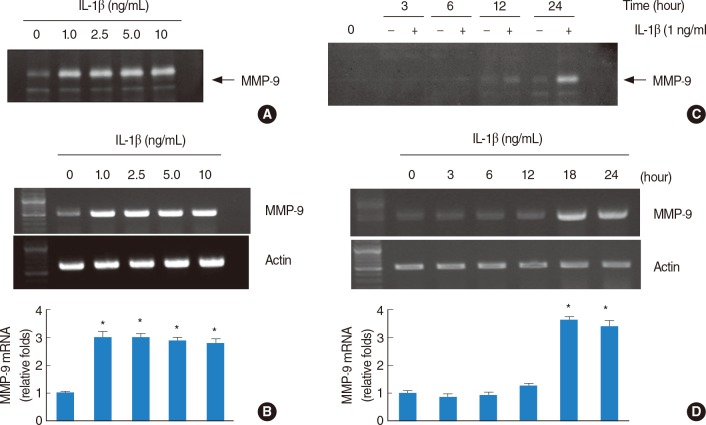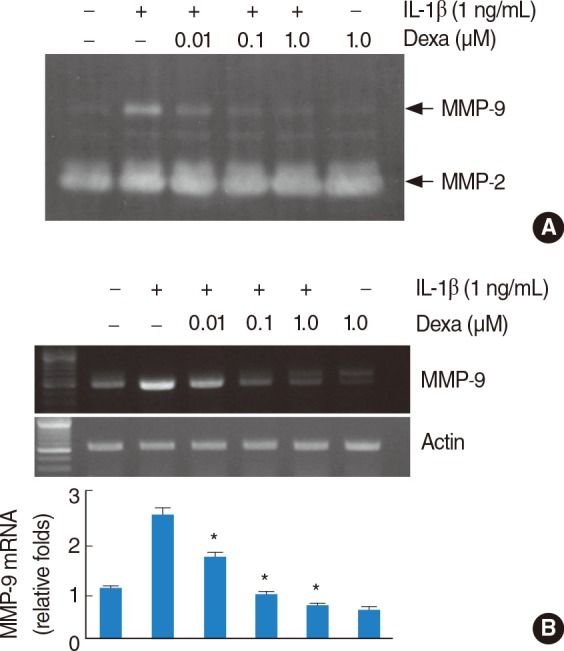INTRODUCTION
MATERIALS AND METHODS
Cell culture
Materials
Gelatin substrate gel zymograph
RNA isolation and reverse transcription-polymerase chain reaction (RT-PCR)
Densitometry
Statistical analysis
RESULTS
IL-1β induces MMP-9 mRNA expression and MMP-9 activity in HEI-OC1 cells
 | Fig. 1Effect of interleukin (IL)-1β on matrix metalloproteinase (MMP)-9 activity in house ear institute-organ of Corti 1 (HEI-OC1) cells. IL-1β increases MMP-9 activity and mRNA expression. (A, B) HEI-OC1 cells were treated with various concentrations of IL-1β for 20 hours. Conditional media were collected after 20 hours and gelatin zymography was performed (A). The MMP-9 mRNA expression levels were determined by reverse transcription-polymerase chain reaction (RT-PCR). The levels of actin were used as a loading control (B). (C, D) HEI-OC1 cells were treated with the 1 ng/mL IL-1β for the indicated time periods. Conditional media were collected after 20 hours and gelatin zymography was performed (C). The MMP-9 mRNA expression levels were determined by RT-PCR. The levels of actin were used as a loading control. The values in (B, D) represent the mean±SD from three independent samples. *P<0.001 compared to the control. The data represent three independent experiments. |
Dexamethasone inhibits IL-1β-induced MMP-9 expression in HEI-OC1 cells
 | Fig. 2Effect of dexamethasone on interleukin (IL)-1β induced matrix metalloproteinase (MMP)-9 activity and MMP-9 mRNA expression. Dexamethasone inhibits IL-1β-induced MMP-9 activity and mRNA expression. House ear institute-organ of Corti 1 (HEI-OC1) cells were treated with the indicated concentrations of dexamethasone in the absence of presence of 1 ng/mL IL-1β for 20 hours. Conditional media were collected after 20 hours and gelatin zymography was performed (A). The MMP-9 mRNA expression levels were determined by reverse transcription-polymerase chain reaction. The levels of actin were used as a loading control. The values in (B) represent the mean±SD from three independent samples. *P<0.001 compared to IL-1β. The data represent three independent experiments. |
Effect of RU486 on inhibitory effect of dexamethasone in IL-1β-induced MMP-9 activity
 | Fig. 3Effect of RU486 on inhibitory effect of dexamethasone in interleukin (IL)-1β-induced matrix metalloproteinase (MMP)-9 activity and mRNA expression. RU486 blocks inhibitory effect of dexamethasone in IL-1β-induced MMP-9 activity and mRNA expression. House ear institute-organ of Corti 1 (HEI-OC1) cells were pretreated with RU486 (10 µM) for 30 minutes, and then treated with the 1 ng/mL IL-1β in the absence or presence of 1 µM dexamethasone (Dex) for 20 hours. Conditional media were collected and gelatin zymography was performed (A). The MMP-9 mRNA expression levels were determined by reverse transcription-polymerase chain reaction. The levels of actin were used as a loading control. The values in (B) represent the mean±SD from three independent samples. *P<0.001 compared to IL-1β plus Dex. The data represent three independent experiments. |
Effects of NAC on IL-1β-induced MMP-9 activity and mRNA expression
 | Fig. 4Effects of N-acetylcysteine (NAC) on interleukin (IL)-1β-induced matrix metalloproteinase (MMP)-9 activity and mRNA expression. Reactive oxygen species signaling is not associated with IL-1β-indcued MMP-9 activity and mRNA expression. House ear institute-organ of Corti 1 (HEI-OC1) cells were pretreated with NAC (5 mM) for 30 minutes, and then added 1 ng/mL IL-1β for 20 hours. Conditional media were collected and gelatin zymography was performed (A). The MMP-9 mRNA expression levels were determined by reverse transcription-polymerase chain reaction. The levels of actin were used as a loading control. The values in (B) represent the mean±SD from three independent samples. The data represent three independent experiments. |
Activation of p38 MAPK signaling pathway is important for IL-1β-induced MMP-9 activity and mRNA expression in HEI-OC1 cells
 | Fig. 5The p38 mitogen-activated protein kinases (MAPK) signaling pathways play important roles in interleukin (IL)-1β-induced matrix metalloproteinase (MMP)-9 activity and mRNA expression in house ear institute-organ of Corti 1 (HEI-OC1) cells. IL-1β induces MMP-9 activity and mRNA expression via the p38 MAPK signaling. (A) HEI-OC1 cells were pretreated with 50 µM ERK inhibitor (PD98059), 10 µM p38 MAPK inhibitor (SB203580), and 20 µM JNK inhibitor (SP600125), and then stimulated with 1 ng/mL IL-1β for 20 hours. Conditional media were collected and gelatin zymography was performed (A). The MMP-9 mRNA expression levels were determined by reverse transcription-polymerase chain reaction. The levels of actin were used as a loading control. The values in (B) represent the mean±SD from three independent samples. *P<0.001 compared to IL-1β. The data represent three independent experiments. |




 PDF
PDF Citation
Citation Print
Print


 XML Download
XML Download